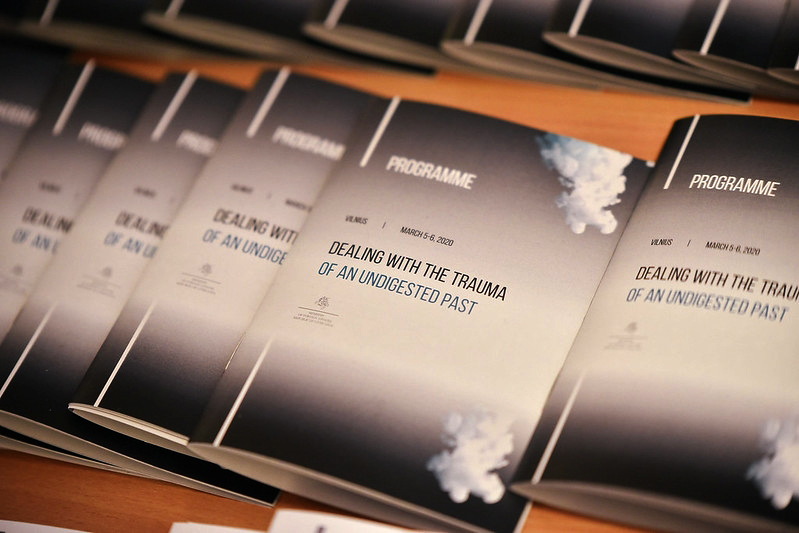
The Ministry of Foreign Affairs (MFA) of Lithuania in collaboration with Andrei Sakharov Research Centre of Vytautas Magnus University, the Psychology Institute of Vilnius University organized a conference titled “Dealing with the trauma of an undigested past” on March 5-6, in Vilnius. The purpose of the conference, opened by the two-term president of Lithuanian Republic Valdas Adamkus (1998-2003, 2004-2009), was to look into the scope of trauma, to discuss its impact on the collective psyche, explore the success and failure of larger entities, particularly nations' in addressing the traumatic effects. The problem of the conference was formulated in the following question: psychotherapy provides tools to individuals to overcome personal traumas, is it possible to use the same tools to help a nation to overcome collective trauma of war, genocide, massacre, or political oppression?
The conference was divided into four sessions where renowned scholars, artists, writers tried to share their own understanding of collective trauma, its causes and methods of probable healing.
In the opening remarks Chancellor of the MFA of the Republic of Lithuania
Laimonas Talat-Kelpsa (1) shared with the audience the idea that the Lithuanian society is ill, and the name of the disease is not COVID-19. Men in Lithuania commit suicide six to seven times more often than women, resulting in one of the highest ratio difference between genders in the world. According to the data provided by the Chancellor, Lithuanians feel depressed, complain about the economic growth of the country, while consumer spending reached an all-time high in 2019. Talat-Kelpsa suggested in his speech that the source of depression and high rate suicides might be the speed of revision of twentieth-century Lithuanian history. This nurtures an identity crisis among the ordinary people, who lose the ability to analyze and reflect on the traumas they had endured.
As there is a good number of scholarly works on Nazi and Communist perpetrators in Lithuania, the MFA Chancellor mentioned that time has come to face the role of native collaborators of both regimes and the Lithuanian responsibility in Holocaust. People that survived 50 years of systematic abuse and injustice had many sources of trauma, for sure. But according to the MFA Chancellor, it is important to acknowledge that Lithuanian pain is unique but not singular. This understanding will facilitate rebuilding bridges with the Jewish, Polish and other communities of the country.
The same hope was expressed by Prof.
Robert Van Voren (Professor of Soviet and post-Soviet studies, Kaunas Vytautas Magnus University, Lithuania). Van Voren emphasized in his speech the fact, that from the beginning of Nazi invasion Jews were killed by Lithuanian civilians sometimes with German involvement, sometimes without. Ordinary people lynched Jews on the streets by blaming them to be the source of the disaster of the Lithuanian people. The killings were followed by expropriation and pillage, creating an episode of the history “left to the generations to digest for almost 80 years”. According to Van Voren, the war changed both the victim and the perpetrator, but to take a step forward together they should come in terms with the past, that can’t be changed.
Prof. Van Voren mentioned that for his book (2) he made a comparison with the Netherlands, as Lithuanians were referred in history as Jew killers, while Dutch as saviors. But the only difference is that Lithuania Jews were killed on the spot, and Dutch put their Jewish citizens in the trains and “let the others do the killing.” Lithuanians know what happened and they feel the tension of being the descendants of both the victims and the perpetrators. At the same time, many Lithuanians speak of the issue of “double genocide” in reference to the exile of Lithuanians to Siberia, which the author doubts from the legal point of view to be as such. However, he has no doubt that the condition of the Lithuanian returnee from Siberia and the Jewish survivor of the Holocaust was the same. A telling example of this was his personal story. Van Voren’s mother in law was deported to Siberia, and when she returned, there was another family living in her parental house. Both the inhabitants and the neighbors that were using her personal belongings had no intention to return them to the owner. It is no different from the fate of a Jew who returned to Amsterdam after the war and the woman who then lived in his apartment exclaimed: “Oh no, why should my Jew return.”
Van Voren concluded that the 20th century was a chain of misfortunes for the Lithuanian nation, which has been victimized and not only by the Communist regime. Sometimes the burden of being a perpetrator is no less than the burden of the victim and the majority of Lithuanians seek explanation, not justification. This is a perfect example of a combination of victim and perpetrator.
To treat the post-traumatic disorder and provide the psychosocial aid to the Holocaust survivors carrying the burden of the victim and their descendants (as trauma does pass through generations) Holocaust Survivors’ Supporting organization - AMCHA was established in 1987 in Israel. Chairman
Lukas Welz in his speech explained that one of the sources of the trauma of Jewish survivors of the Holocaust was non-recognition. Even in Israel people hardly believed in the stories of the survivors. This started changing only after the Eichmann trial. The next traumatizing aspect was the self-victimization of Germans. Welz clarified that German losses during WWII are immense, but “this is not equal pain”.
The interesting remark in his report was that in some cases the source of the trauma is unpredictable. As stated in the interview of an AMCHA patient, the day of the liberation of the concentration camp was traumatizing: the doors that were closed for five years were opened, and the survivors were told to go. And at that moment they realized, that there was no place to go and no one to see. And this condition of “total homelessness” caused a trauma. Another patient, the daughter of two Auschwitz survivors confessed that her mother hated her, as she brought colors to her life, which used to be black and grey.
It was emphasized several times during the conference that the memorization of traumatic events is crucial for overcoming the psychological trauma. While stressing its importance
Yves Doutriaux (Member of the Conseil d’Etat, former Ambassador of France at OSCE) highlighted, that the “political reading of history” must be avoided. As an example Doutriaux brought the 2005 French law on colonialism, article 4 of which imposed on high-school teachers to teach the "positive values" of colonialism and raised a huge debate among the scholars and public in France (3). The second example was the erection of national monument and war memorial of Algeria and the fighting in Morocco and Tunisia (Le Mémorial national de la guerre d'Algérie et des combats du Maroc et de la Tunisie). Memorial, which was officially inaugurated on 5th December 2002 by the French President Jacques Chirac, is a tribute to the French soldiers and civilians that died during and after the Algerian war (1954-1962). Native victims, French war crimes and colonialism were not included in the narrative of the memorial. Doutriaux qualified both examples as “nostalgia of colonization,” and suggested at least to discuss the history of 1.2 M slaves traded by French slave traders.
Director of the Institute for Historical Justice and Reconciliation in Hague Dr.
Timothy Ryback discussed several examples of “successful” memorials. According to Ryback historical narratives change in time, so memorials should not be imposing and massive. The first example was “stumbling stones” in Berlin. They are commemorating people persecuted by the Nazi regime from 1933-1945 by giving compressed narratives in a small space. The stones represent a new vision of urban remembrance and focus on individual tragedies. Another example was the statue of “comfort woman” in Seoul across from the Japanese embassy. The Statue of Peace was erected to call for apology and remembrance of the Korean victims of sexual slavery by the Japanese military during WWII. The empty chair next to the statue suggests one to sit and put himself/herself in the place of the victims, which for a long period of time were not accepted by their own society. The line was kept by internationally renowned Lithuanian artist
Esther Shalev-Gerz, who stated that memorials should be engaging and thought-provoking. She presented one of her first works erected in Hamburg in 1986 – the monument against fascism. Installed in a public square the monument is a 12 meter-high column, clad in lead. With the metal pencil, residents were invited to engrave their names directly onto the surface of the monument to express their attitude against fascism. As the artist explained a piece of stone should be an opportunity for self-expression: “Monuments do not fight against Fascism, people do”.
To change the attitude of individuals and groups Prof.
Vamik Volkan (Prof. Emeritus of Virginia University, President Emeritus of International Dialogue Initiative (4), four-time Nobel Peace Prize Nominee) and
Armand Volkas (psychotherapist and registered drama therapist) work with conflicting groups such as Japanese-Korean, Armenian-Turkish, Jewish-German, to facilitate reconciliation. The trauma causes anger and indifference on both individual and group levels, which in turn seeds new conflict and new trauma. An example of this was provided by consultant psychiatrist Dr. Mahesan Ganesan, who works at the National Institute of Mental Health in Sri Lanka. As he stated the civil war ended in the country (1983-2009) but the population still struggles the aftermath. Violence is routinized, forced disappearances, human rights abuses, domestic violence became a part of daily life. The family members are not able to find and bury the relatives, to mourn those that are passed away. This is an unresolved conflict and a source of new traumas, that destroy human lives and traditional societal ties.
According to
Simon Wessely, a professor of psychological medicine at King's College of London, the discussion and acknowledgment of the past, which is a painful thing to do, is important both individually and collectively. As Wessely stated justly “A single person can be a perpetrator a victim and a bystander at different times in his life. So it is with countries and so it is with cultures.”
The conference was closed by MFA Chancellor Laimonas Talat-Kelpsa, who presented the “Vilnius Declaration on Dealing with the Consequences of Collective Trauma,” (5) which was decided to make public after the conference. He also expressed hope that the delegates representing different countries would take the idea and organize the second round of the conference.
Overall the conference could be summed up by the following remarks:
1. Collective trauma is a collective moral dilemma that arises from the choices which the group made at some point in its history.
2. Traumas are universal, they do happen everywhere geographically different is our attitude towards it.
3. What “we” as a collectiveness endured usually dominates the debate on trauma.
4. Recognition, public apologies, memorization, complete mourning, and reparations, even symbolic ones are crucial steps towards healing the group.
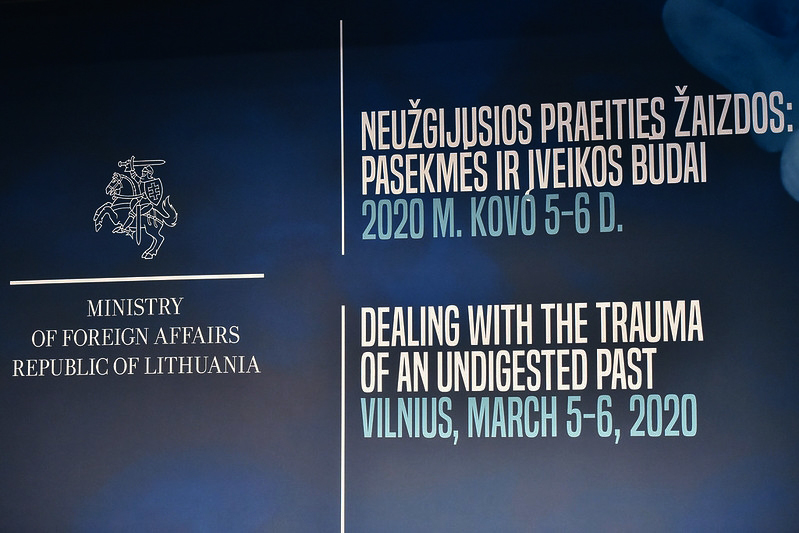

Ex-President of Lithuania Valdas Adamkus giving an opening speech at the Conference

“Stolperstein” or a stumbling stone commemorating Max Laske in Berlin, murdered or disappeared in Sachsenhausen consentration camp

The Statue of Peace or Comfort Woman Statue, facing the Embassy of Japan in Seoul, erected in 2011
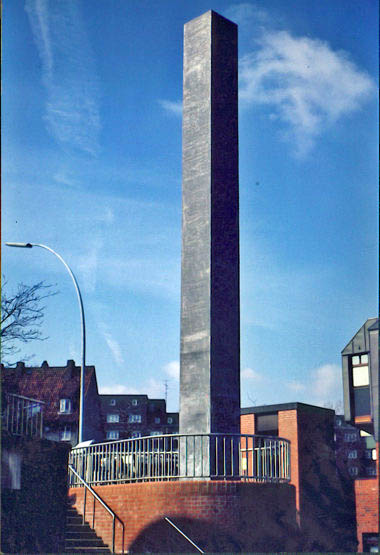
The Monument against Fascism erected in Hamburg, Germany, 1986-1993
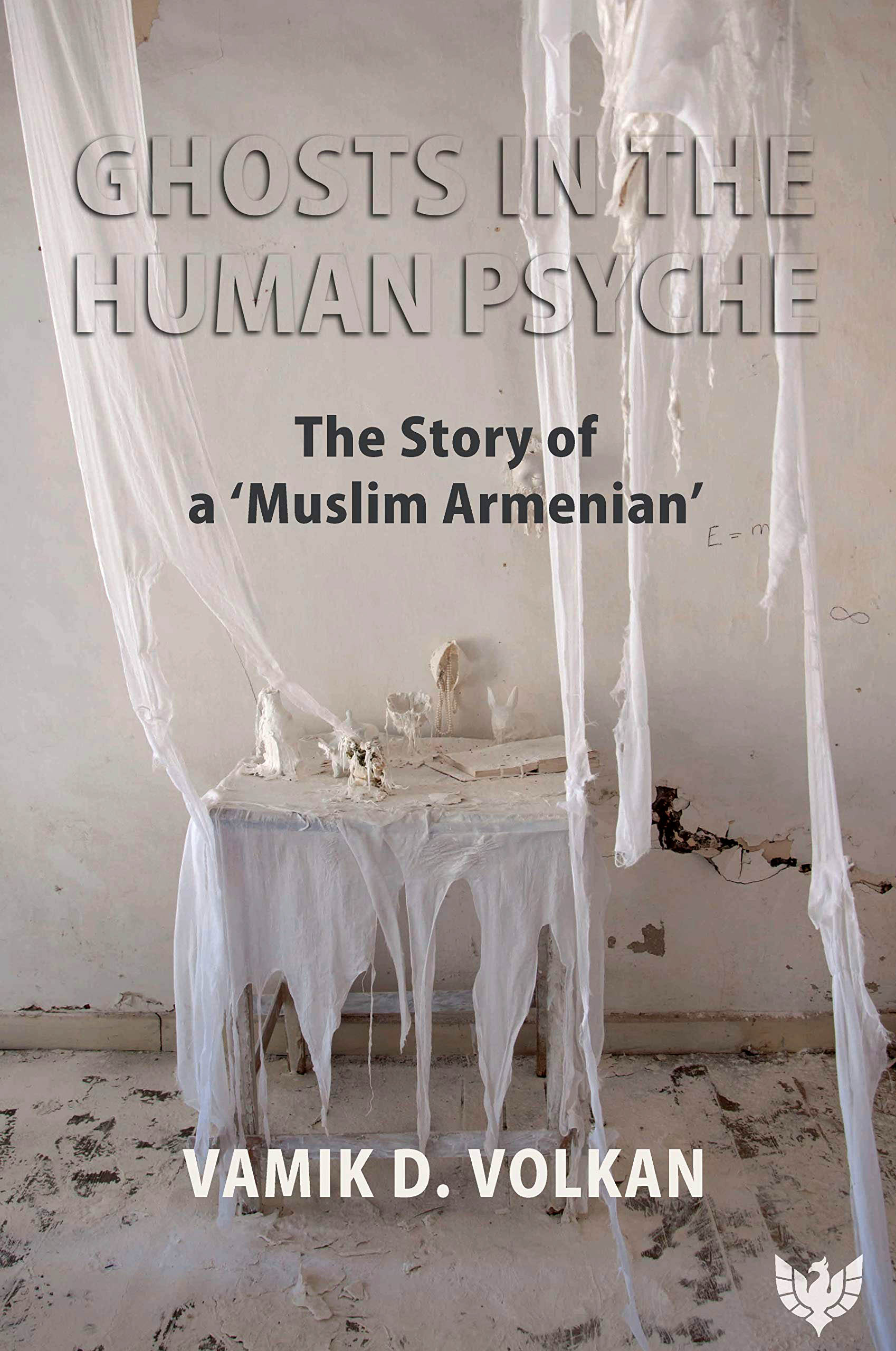
Vamik D. Volkan, Ghosts in the Human Psyche: The Story of a “Muslim Armenian”, Phoenix Publishing House, 1 edition, 2019, pp. 124
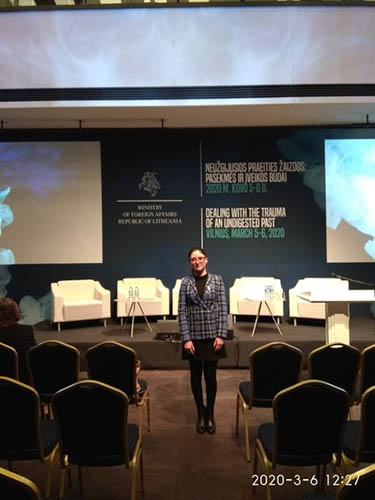
The delegate of the AGMI, researcher Regina Galustyan at the conference
___________________________________________
1. See the whole speech at: https://www.lrt.lt/en/news-in-english/19/1148089/what-is-wrong-with-us-opinion.
2. Van Voren, Robert, Undigested Past: The Holocaust in Lithuania. (On the Boundary of Two Worlds), Rodopi, 2011, pp. 210.
3. Article 4 was repealed by president Jacques Chirac (UMP) at the beginning of 2006.
4. https://www.internationaldialogueinitiative.com/
5.http://urm.lt/default/en/news/societies-having-not-overcome-their-traumas-pass-them-on-to-future-generations-policy-history-arts-and-medical-experts-say





